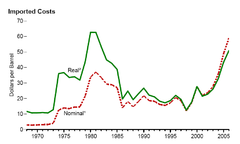
Back أزمة الطاقة في السبعينات Arabic Crisi de l'energia de la dècada de 1970 Catalan Ropný šok Czech Oliekrise Danish Ölpreiskrise German Ενεργειακή κρίση της δεκαετίας του 1970 Greek Crisis energética de los setenta Spanish Öljykriisi Finnish Choc pétrolier French Naftna kriza Croatian
 Real and nominal price of oil, 1968–2006.[1] | |
| Date | 1973–1980 |
|---|---|
| Also known as | 1970s oil crisis |
The 1970s energy crisis occurred when the Western world, particularly the United States, Canada, Western Europe, Australia, and New Zealand, faced substantial petroleum shortages as well as elevated prices. The two worst crises of this period were the 1973 oil crisis and the 1979 energy crisis, when, respectively, the Yom Kippur War and the Iranian Revolution triggered interruptions in Middle Eastern oil exports.[2]
The crisis began to unfold as petroleum production in the United States and some other parts of the world peaked in the late 1960s and early 1970s.[3] World oil production per capita began a long-term decline after 1979.[4] The oil crises prompted the first shift towards energy-saving (in particular, fossil fuel-saving) technologies.[5]
The major industrial centers of the world were forced to contend with escalating issues related to petroleum supply. Western countries relied on the resources of countries in the Middle East and other parts of the world. The crisis led to stagnant economic growth in many countries as oil prices surged.[6] Although there were genuine concerns with supply, part of the run-up in prices resulted from the perception of a crisis. The combination of stagnant growth and price inflation during this era led to the coinage of the term stagflation.[7] By the 1980s, both the recessions of the 1970s and adjustments in local economies to become more efficient in petroleum usage, controlled demand sufficiently for petroleum prices worldwide to return to more sustainable levels.
The period was not uniformly negative for all economies. Petroleum-rich countries in the Middle East benefited from increased prices and the slowing production in other areas of the world. Some other countries, such as Norway, Mexico, and Venezuela, benefited as well. In the United States, Texas and Alaska, as well as some other oil-producing areas, experienced major economic booms due to soaring oil prices even as most of the rest of the nation struggled with the stagnant economy. Many of these economic gains, however, came to a halt as prices stabilized and dropped in the 1980s.
- ^ "Annual Energy Review 2006, Figure 5.21" (PDF). U.S. Energy Information Administration, Department of Energy. June 2007. Retrieved 30 May 2016.
- ^ "Oil Squeeze". Time. 1979-02-05. Archived from the original on 7 March 2008. Retrieved 7 September 2013.
- ^ Hubbert, Marion King (June 1956). Nuclear Energy and the Fossil Fuels 'Drilling and Production Practice' (PDF). Spring Meeting of the Southern District. Division of Production. American Petroleum Institute. San Antonio, Texas: Shell Development Company. pp. 22–27. Archived from the original (PDF) on 2008-05-27. Retrieved 2008-04-18.
- ^ Duncan, Richard C (November 2001). "The Peak of World Oil Production and the Road to the Olduvai Gorge". Population and Environment. 22 (5): 503–22. doi:10.1023/A:1010793021451. ISSN 1573-7810. S2CID 150522386. Archived from the original on 2009-06-24. Retrieved 2009-07-11.
- ^ Hassler, John; Krusell, Per; Olovsson, Conny (2021). "Directed Technical Change as a Response to Natural Resource Scarcity". Journal of Political Economy. 129 (11): 3039–3072. doi:10.1086/715849. hdl:10419/215453. ISSN 0022-3808. S2CID 199428841.
- ^ Mohammed, Mikidadu (2017). Essays on the Causes and Dynamic Effects of Oil Price Shocks. University of Utah. Retrieved 27 January 2020.
- ^ Mankiw, N. Gregory; Scarth William M. (2003). Macroeconomics: Canadian Edition Updated. New York: Worth Publishers. p. 270. ISBN 978-0-7167-5928-7. Retrieved 13 November 2009.